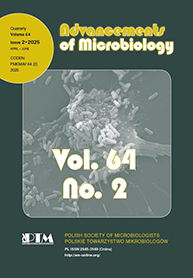GENEROWANIE MOSTKÓW DISIARCZKOWYCH W BIAŁKACH – RÓŻNORODNOŚĆ STRUKTURALNA I FUNKCJONALNA BIAŁEK DSBA
Streszczenie: Białka Dsb katalizują wprowadzanie mostków disiarczkowych pomiędzy grupami tiolowymi reszt cysteinowych do białek pozacytoplazmatycznych w komórkach bakterii. Proces ten warunkuje osiągnięcie przez białka prawidłowej struktury, umożliwiającej pełnienie funkcji w komórce. Najlepiej poznanym i scharakteryzowanym białkiem zaangażowanym w proces wprowadzania mostków disiarczkowych jest monomeryczna oksydoreduktaza DsbA, działająca w komórkach modelowego organizmu Escherichia coli. Badania
wielu mikroorganizmów pokazały ogromną różnorodność funkcjonowania szlaku wprowadzania mostków disiarczkowych. W prezentowanej pracy zebrano informacje charakteryzujące wyodrębnione strukturalne i filogenetyczne grupy białek DsbA różnych gatunków bakterii. Opisano ich właściwości fizykochemiczne a także oddziaływania z partnerami redoks oraz substratami. Skoncentrowano się również na opisaniu dimerycznych białek, pełniących rolę w procesie wprowadzania mostków disiarczkowych. Ponieważ białka Dsb decydują często o aktywności czynników wirulencji, poznanie ich struktur i mechanizmów działania może przyśpieszyć opracowanie
nowych terapii antybakteryjnych.
1. Wstęp. 2. System białek Dsb Escherichia coli. 2.1. Charakterystyka tiolowej oksydoreduktazy E. coli – białka DsbA. 2.2. Białka szlaku izomeryzacji-redukcji. 3. Klasyfikacja monomerycznych białek DsbA. 3.1. Fizyczno-chemiczne właściwości różnych grup DsbA. 4. Oddziaływanie DsbA z dwiema grupami substratów – partnerami redoks oraz substratami. 4.1. Oddziaływanie z partnerami redoks. 4.2. Oddziaływanie z substratami. 5. Dimeryczne oksydoreduktazy o aktywności oksydacyjnej. 6. Podsumowanie. 7. Piśmiennictwo
Abstract: Bacterial proteins of the Dsb (disulfide bond) system catalyze the formation of disulfide bridges, a post-translational modification of extra-cytoplasmic proteins, which leads to stabilization of their tertiary and quaternary structures and often influences their activity. DsbA – Escherichia coli monomeric oxidoreductase is the best studied protein involved in this process. Recent rapid advances in global analysis of bacteria have thrown light on the enormous diversity among bacterial Dsb systems. The set of Dsb proteins involved in the oxidative pathway, varies, depending on the microorganism. In this article we have focused on characterization of structural and phylogenetic groups of monomeric DsbAs. This review discuss their physicochemical features and interactions with redox partners as well as with substrate proteins. The last part of the review concentrates on dimeric oxidoreductases responsible for disulfide generation. Many virulence factors are the substrates of the Dsb proteins. Thus unraveling the machinery that introduces disulfide bonds and expanding knowledge about Dsb protein structures and their activities may facilitate the discovery of an effective anti-bacterial drugs.
1. Introduction. 2. Escherichia coli Dsb system. 2.1. Characteristic of the E. coli thiol oxidoreductase – DsbA. 2.2. Izomerization / reduction pathway proteins. 3. Classification of the monomeric DsbAs. 3.1. Physicochemical features of different classes of DsbAs. 4. DsbA interactions with redox partner and substrates. 4.1. DsbA interactions with redox partner. 4.2. DsbA interactions with substrates. 5. Dimeric Dsb proteins with oxidative activity. 6. Conclusions. 7. References

